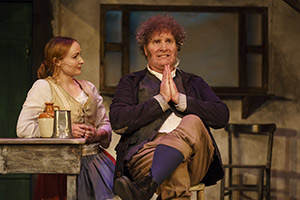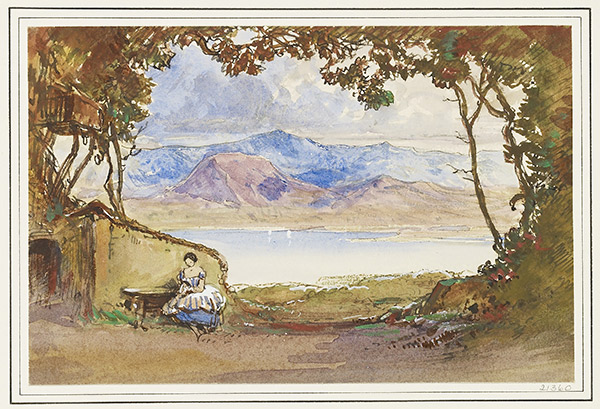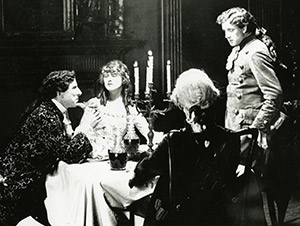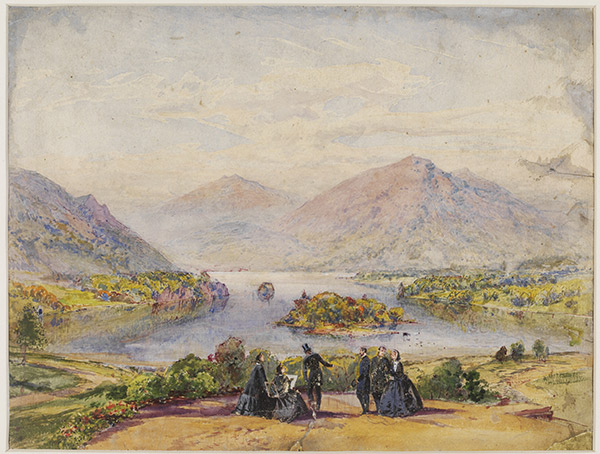The Colleen Bawn and tourism in Killarney
Published in 18th-19th Century Social Perspectives, 18th–19th - Century History, 20th Century Social Perspectives, 20th-century / Contemporary History, Features, Issue 1 (January/February 2019), Volume 27This year will mark the 200th anniversary of one of Ireland’s most notorious murders: the brutal killing of a beautiful fifteen-year-old peasant girl called Ellie Hanley, who became known asthe Colleen Bawn.
By Robert Whelan
Elopement and sham marriage

Ellie Hanley lived in Ballicahane, just outside the city of Limerick. Her great beauty attracted the attention of John Scanlan, whose family lived in Ballicahane Castle, less than a mile from her cottage. He persuaded her to elope with him on the night of 29 June 1819, taking with her 100 pounds in notes and twelve guineas in gold—her uncle’s life savings. There was some sort of wedding ceremony in Limerick; it was probably a sham but Ellie was convinced that she really was Mrs Scanlan. Scanlan told her that the time was not yet right to introduce her to his family, so he installed her in a house in nearby Glin. He was a frequent visitor to Glin for its shooting, fishing and boating, so his frequent trips there would not arouse suspicion.
Scanlan quickly tired of his beautiful peasant girl and decided to get rid of her. On the night of 19 July 1819, he, Ellie and his boatman Stephen Sullivan were preparing to cross the Shannon estuary from Kilrush, Co. Clare, to Glin. Sullivan hero-worshipped his master and would do anything for him. They were inseparable and had a relationship that was more like brothers than master and servant. The night of 19 July was foul and a group of four other people wantedto cross to Glin that night. One member of this group—Ellen Walsh—already knew Scanlan and Ellie, as she had been employed as Ellie’s maid when the girl was first installed in Glin. She asked Scanlan whether the four of them could come in his boat and he agreed.
A storm blew up that was so severe that they were in danger of drowning, so theboat put in at Carrigafoyle, where they all spent the night. The next morning Ellen Walsh and her three companions set off for Glin, leaving Scanlan, Sullivan and Ellie in Carrigafoyle. That was the last time Ellie was seen alive.
The three went to Ballylongford, where Scanlan bought a boat and told Sullivan that he wanted Ellie dead. He left Ellie alone with Sullivan during the day, but was angry to find on his return that Sullivan hadn’t been able to bring himself to do the deed. He left the boat again, warning Sullivan not to fail a second time. Sullivan took the boat out into the middle of the Shannon during the night and beat Ellie to death. He tied her body to a large stone and threw her overboard. Ellie’s ‘marriage’ had lasted less than four weeks.
Three weeks later Ellie’s body was washed up on the shore of the Shannon at Moneypoint, so badly disfigured that she could only be identified by two unusual double teeth on either side of her upper jaw. Warrants were issued for the arrest of Scanlan and Sullivan, both of whom had disappeared. Scanlan was caught hiding in his parents’ castle on 14 November, and on 11 March 1820 hewent on trial for murder, defended by Daniel O’Connell. O’Connell argued that,as their marriage had been a sham, Scanlan had no need to kill Ellie, since the people he mixed with would have taken a very lenient view of the seduction and ruin of a peasant girl. Nevertheless, the jury found him guilty and he was hanged on 16 March 1820, protesting his innocence.

Two months later Sullivan was found, imprisoned in Tralee Gaol under a false name for passing forged banknotes. He was tried, found guilty and sentenced to death on 25 July 1820. The prison chaplain told him that it was time to come clean about the affair before he met his maker, so Sullivan confessed on the scaffold. He admitted to the murder, which he had carried out on Scanlan’s orders.
Gerald Griffin’s The Collegians
The Irish writer Gerald Griffin was born in the same year as Ellie Hanley and grew up in Limerick, only a few miles from her cottage. Like everyone in Limerick, the teenager would have been gripped by the horrible tale as it unfolded. Griffin wanted to be a writer, and at the age of twenty he travelled to London to make a name for himself as a playwright. Three years later he returned to Ireland,disillusioned with London and with the theatre, and determined to write tales of Irish life. One of these was The Collegians, based on the Hanley murder and published in 1829 when he was still only 25.
Griffin turned John Scanlan into Hardress Cregan, the spoiled son of a wealthy family who is passionate and inconstant but not wicked. He is afraid of his domineering mother, who wants him to marry the heiress Anne Chute. He tells his mother that he is otherwise committed, but doesn’t actually say that he is married. (The marriage in The Collegiansis real.) His mother is so angry that he agrees to at least consider a match with Anne Chute, and the family then move from Limerick to Dinis Cottage, on the shore of the Lakes of Killarney, for a period of courtship.
Hardress Cregan has meanwhile moved his peasant bride—called Eily O’Connor in the novel and christened the Colleen Bawn by Griffin—into a cottage in Killarney with the sister of his boatman (here called Danny Mann). Cregan is able to escape from his mother’s house and travel to see Eily late at night. He falls in love with Anne Chute, however, and begins to regret his marriage to Eily. He tries to avoid proposing to Anne but is eventually pressured to do so by his mother.Danny Mann offers to take care of the situation and Cregan agrees. Mann takes Eily out onto the lake, where he beats her to death and throws the corpse into the water. Like their real-life counterparts, Cregan and Danny Mann are convicted of the murder and hanged.
Dion Boucicault’s Colleen Bawn

(Ade Desbrow)
Thirty years after the publication of The Collegians, the Irish playwright Dion Boucicault was working in New York with the American actor-manager Laura Keene. Boucicault’s job was to keep her supplied with plays, which he could write with astonishing speed, but one of his plays failed so badly that it became obvious that it would have to be taken off—and there was nothing to replace it. Boucicault was already working on a stage version of The Collegians for another manager but he decided to give it to Laura Keene instead. He sent her aset of steel engravings of the Lakes of Killarney, telling her to get her scene-painter working on the sets because he would have a new play ready forher to open in two weeks.
The fact that Boucicault sent Laura Keene the engravings of Killarney before sheeven had the script shows how important the location was to him, because,whereas Gerald Griffin had set part of the action of The Collegians there, Boucicault moved the whole story toKillarney. He also gave it a happy ending.
Boucicault’s Hardress Cregan has no intention of ever harming the Colleen; the wicked plot is conceived by Danny Mann, who takes the Colleen out in a boat on the lakes and tries to murder her. He has steered his boat into a ‘water-cave’ on Devil’s Island, however, where Myles-na-Coppaleen has an illegal whiskey still. When Myles, who is above them, hears the screaming, he rushes down with his gun and shoots Danny, who falls into the water. Myles then sees the Colleen drowning, dives into the lake and saves her.
Myles-na-Coppaleenhad appeared in The Collegians, but only as a minor character. Boucicault, who intended the part for himself, made Myles the hero of his play, a lovable rogue who cherishes a passion for the Colleen Bawn which he knows is hopeless, but he promises to look out for her always. Having saved the Colleen, Myles hides her in his cottage. When her shawl is found floating in the lake, she is assumed to have drowned herself, but Danny Mann makes a deathbed confession that is overheard, implicating Hardress Cregan in her murder. Troops arrive at the wedding of Cregan to Anne Chute to arrest him, but Myles saves the day by bringing in the Colleen alive.
Killarney and tourism
The Colleen Bawn was a huge success in New York and in London, where it opened at the Adelphi Theatre on 10 September 1860. One of the play’s greatest admirers in London was Queen Victoria, who went to see it three times and commissioned a series of paintings of scenes from the play. In August of that year the queen made her third visit to Ireland; whereas she had previously stayed in major cities, this time she visited Killarney. The two leading families of the local gentry—the Herberts of Muckross House and the earls of Kenmare—had been developing tourism in Killarney since the eighteenth century. Henry Herbert and Thomas Browne, third earl of Kenmare, were both well connected at court and had been pressing for a royal visit for some time, well aware of its publicity value, but the fact that Queen Victoria wanted to seethe scenery of Killarney in 1861 was probably related to her memories of the painted scenery at the Adelphi Theatre earlier that year.
Tourism had been growing in Killarney throughout the first half of the nineteenth century, but the publicity surrounding Queen Victoria’s visit took it to a new level, persuading many of her subjects to visit Killarney as an alternative tothe Lake District in Cumbria. Many of these visitors shared the queen’s fascination with the Colleen Bawn and started asking to see the sites. Rather than disappoint the visitors, ‘Devil’s Island’ and the ‘Colleen Bawn Rock’ were ‘discovered’ in Muckross Lake. A 1911 silent film version of the play, shot in Killarney, showed audiences ‘the real Anne Chute Castle and an exact reproduction of the interior’. As Anne Chute is a fictional character, there is no Chute Castle,but by this stage it hardly mattered. The Colleen Bawn belonged to Killarney.
Edmund Falconer’s Little Red Riding Hood and Killarney
Meanwhile, back in London’s theatre land, the Irish actor-manager-playwright Edmund Falconer, who had played Danny Mann in the original London cast of The Colleen Bawn, was planning to cash in on the queen’s visit with his pantomime Little Red Riding Hood at the Lyceum Theatre. In this updated version of the fairy story, Baron Wolf pursued the heroine through England, Scotland and Ireland.The sequence in Ireland contained a panorama of the Lakes of Killarney painted by William Telbin. Panoramas were popular scenic effects in the Victorian theatre, requiring a very long sheet of canvas that was scrolled between two vertical rollers at the back of the stage. They usually represented a journey,but in this case there were six separate scenes of Killarney, side by side,which glided across the stage. They caused a sensation: ‘Nothing so perfect of its kind has ever been produced on the stage’, said The Times, and the public agreed. They flocked to see Killarney and prolonged the run of Little Red Riding Hood until April 1862. Falconer must have realised that he couldn’t run a pantomime through the summer, but the panorama was still popular, so he used it as the basis for a ballet, just called Killarney,with music by the Irish composer Michael Balfe. It contained the ballad‘Killarney’, with music by Balfe and lyrics by Falconer, which remained popular well into the twentieth century. The ballet was still running in November 1862,when Falconer’s lease on the Lyceum came to an end, but the panorama had a long after life, scrolling across the stages of other theatres in London and Manchester. In 1862 Julius Benedict turned Dion Boucicault’s play into an opera at Covent Garden called TheLily of Killarney, fixing the story even more firmly in Kerry.

As news of the murder of Ellie Hanley spread around Limerick in 1819, a kindly academic called Peadar O’Connell offered his own grave in Burrane churchyard asher final resting place. She lies there still, with the gravestone, which lies flat on the ground, encased in a concrete surround to prevent souvenir-hunters from chipping it away. After 200 years, surely it is time for a statue of thereal Colleen Bawn in Killarney, where the poor girl has done so much to promotetourism in a place she never knew.
Robert Whelan writes on theatre history and is the author of The other national theatre: 350 years of shows in Drury Lane (Jacob Tonson, 2013).
FURTHER READING
J. Cronin, Gerald Griffin (1803–1840): a critical biography (Cambridge, 1978).
R. Fawkes, Dion Boucicault: a biography (London, 1979).
D. Horgan, Echo after echo: Killarney and its history (Cork, 1988).
W. Mac Lysaght, Death sails the Shannon: the authentic story of the Colleen Bawn (Tralee, 1953).
















